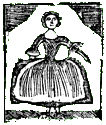The Evidence for Paine as a Staymaker
This fraud apparently fooled every historian and biographer who has written about Paine. At least, the citations that Wikipedia editor “Jkfkauia” inserted after that statement did not actually name any scholar who had seen through the ruse. In fact, those citations offer no outside support for the new statement.
Normally I’d point out that “Jkfkauia” has the responsibility to provide evidence for a claim, especially if he or she is going to dress it up with footnotes. Skeptics don’t have the burden of proving a historical statement is untenable. But I can’t resist poking some holes in the theory.
First, it wasn’t just Paine’s enemies who wrote that he had trained as a staymaker. Paine’s friends did, too. The jokes about Paine making stays for women appeared during and shortly after his lifetime when he or his friends could have refuted them. After all, Paine didn’t build a career as a political writer on two continents by staying quiet about his opponents’ errors.
Second, I have yet to find any eighteenth-century use of the word “staymaker” to mean someone who made stays for ships. Those were a type of rope, and the common term for someone who made ropes was “ropemaker.” If “staymaker” was also used for someone who spun stays for ships, there would surely be period sources remarking on its double meaning.
Instead, sources like this guide to professions from 1747, defined “The Stay-Maker” as “employed in making Stays, Jumps, and Bodice for Ladies.” (That book went on to nasty remarks about women before getting to the working conditions and wages young staymakers might expect.) And here’s a court case from 1771 when “James Paterson, staymaker,” sued to be paid for “furnishings to Taylor’s wife and daughter.”
Furthermore, Paine’s early biographers identified particular staymakers he worked for: his father in Thetford, a “Mr. Morris” on Hanover Street in London, and a “Mr. Grace” in Dover. Records from the late 1700s have helped recent biographers identify the latter two as John Morris and Benjamin Grace. Morris was in fashionable Covent Garden, not a shipbuilding center.
Thetford is an inland town in the east of England. According to “Jkfkauia,” Thomas’s father John Pain was supplying a port downriver with ropes, but it wouldn’t have made economic sense for a ropemaker serving ships to be so far away from the sea. On the other hand, half the people in Thetford needed stays. Making them was a steady, skilled profession.
In fact, Thomas Paine wasn’t the only British political writer of the period who had been trained to make stays. Hugh Kelly, who wrote propaganda for Lord North and plays and poems for himself, was also apprenticed to a staymaker as a teenager. And, like Paine, people who disliked Kelly didn’t let him forget that he’d trained to sew women’s underwear. Because he had.













_and_Mrs_Paul_Sandby_(1736-1797)%2C_by_Paul_Sandby_(1731-1809).jpg/296px-George_Alexander_Stevens_(1710-80)_and_Mrs_Paul_Sandby_(1736-1797)%2C_by_Paul_Sandby_(1731-1809).jpg)




